It’s officially spring, and almost like clockwork, several seasonal caterpillars have begun to emerge from our trees…and may have found their way onto our walls, benches, and well, just about everywhere. While their presence may be a nuisance to some, these caterpillars are (mostly) harmless and serve as an important food source for birds, bats, lizards, and other animals.
Learn more about the springtime caterpillars of Sarasota County below.
Tussock moth (Orgyia spp.)
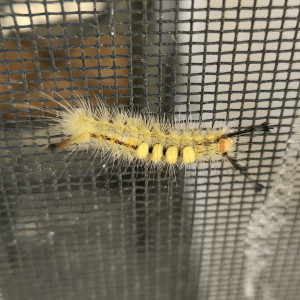
Well, if it isn’t everybody’s favorite caterpillar, the tussock moth. Okay, perhaps that’s a bit misleading. This caterpillar is the cause of many complaints, as it tends to crawl on just about any structural surface before getting ready to pupate, or cocoon. They can also be incredibly numerous, with occasional outbreaks of hundreds congregating in urban areas. There are three common species found in Florida: the fir tussock moth (Orgyia detrita), definite tussock moth (Orgyia definita), and white-marked tussock moth (Orgyia leucostigma).
| Description: |
|
| Host plants: |
|
Read more here.
Oak leafroller (Archips semiferanus)
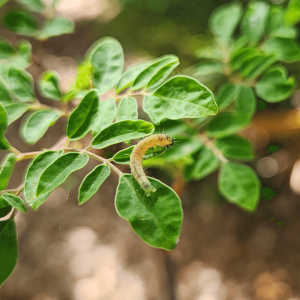
These green caterpillars often pop up in our parks and natural areas, occasionally surprising unaware passersby. Commonly called “inchworms,” oak leafrollers are sometimes found dangling from the lower canopy of oak trees on a thin strand of silk. They earned their nickname through their distinct movement style, which is a slow, repetitive looping. Coincidentally, they often are up to about an inch in length.
Oak leafrollers use their silk to roll up oak leaves before feeding on them from the inside. This also helps them hide from potential predators. Although they feed on oak trees, they very rarely cause enough damage to warrant chemical intervention. In fact, there are many natural predators that help keep populations in check! Caterpillars will feed for about a month before dropping to the ground, pupating, and emerging as similarly small moths in the late spring and summer months.
| Description: |
|
| Host plants: |
|
Another similar species found in Florida is the oak leaftier (Croesia semipurpurana). Read more about both species here.
Wooly gray moth (Lycia ypsilon)
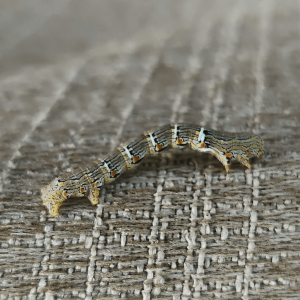
The caterpillar of this moth greatly resembles a twig, but upon closer look, it’s actually quite colorful! With shades of brown, yellow, red, white, and black, it sure is a beauty to behold. The wooly gray moth, along with the oak leafroller, belong to the family Geometridae, commonly referred to as the geometer moths. This species, like many other geometer moth caterpillars, moves in a looping pattern.
| Description: |
|
| Host plants: |
|
Read more here.
Echo moth (Seirarctia echo)
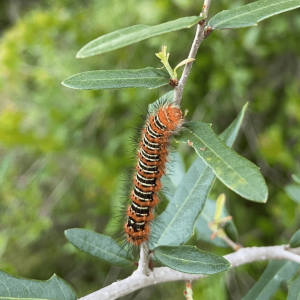
Arguably one of the most iconic caterpillars in Sarasota County, the echo moth can commonly be found in parks and natural areas where its preferred host plants are abundantly available. It is one of the few caterpillars that can tolerate eating the toxic coontie plant, along with the Atala butterfly. However, it will feed on a wide range of woody plants. Although they tend to peak in the spring, the echo moth can be found throughout the year.
While their hairy bodies may look intimidating, echo moth caterpillars are not reported as venomous. However, handling them may result in contact dermatitis for some sensitive individuals. They are also toxic when ingested, not that any of you are considering it. At least, I really hope not.
| Description: |
|
| Host plants: |
|
Read more here.
Management
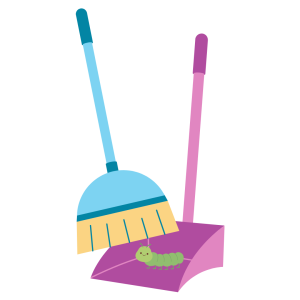 Given the seasonal nature of these caterpillars, it’s best to leave them be. If you really need to control them, consider using a Bt spray formulated for caterpillars. Make sure to follow the directions on the label and apply the spray to their food source (host plants outlined above), as it must be ingested to work. Caterpillars that remain relatively still on structures are likely too close to pupation and no longer need to eat. While Bt spray will not be effective in treating them, spinosad may work as a contact insecticide.
Given the seasonal nature of these caterpillars, it’s best to leave them be. If you really need to control them, consider using a Bt spray formulated for caterpillars. Make sure to follow the directions on the label and apply the spray to their food source (host plants outlined above), as it must be ingested to work. Caterpillars that remain relatively still on structures are likely too close to pupation and no longer need to eat. While Bt spray will not be effective in treating them, spinosad may work as a contact insecticide.
If they make their way into the home, you can remove them by using a broom to gently sweep them into a dustpan, then relocate them back outside. Make sure to check around the foundation, garage, windows, and doors for possible points of entry, then seal them up to prevent more caterpillars from coming inside.
Cocoons can be removed, when needed, by using tweezers. Make sure to wear proper protection when doing so, as some caterpillars may shed stinging hairs when disturbed.
If you have a caterpillar concern, consider using our online insect identification service to receive an identification and management suggestions.
Resources
- UF/IFAS: Tussock Moth Caterpillars in Northcentral Florida
- UF/IFAS Extension Pinellas County: For the love of caterpillars!
- UF/IFAS Gardening Solutions: Biopesticides: Bt and Spinosad
 12
12
